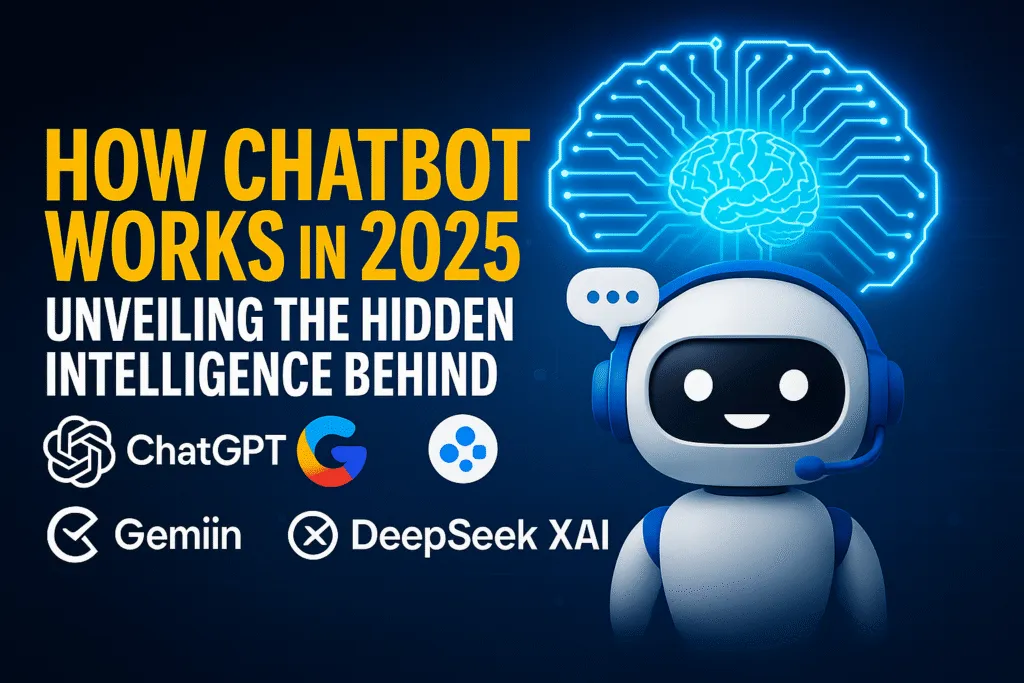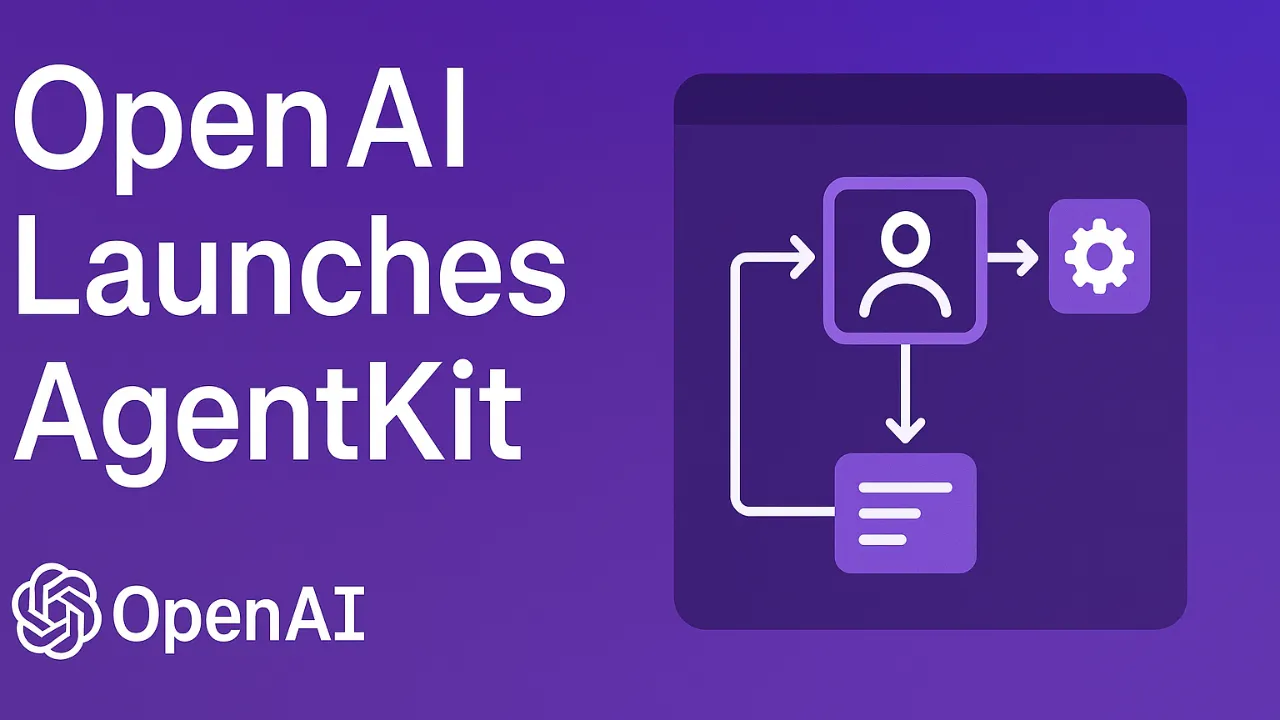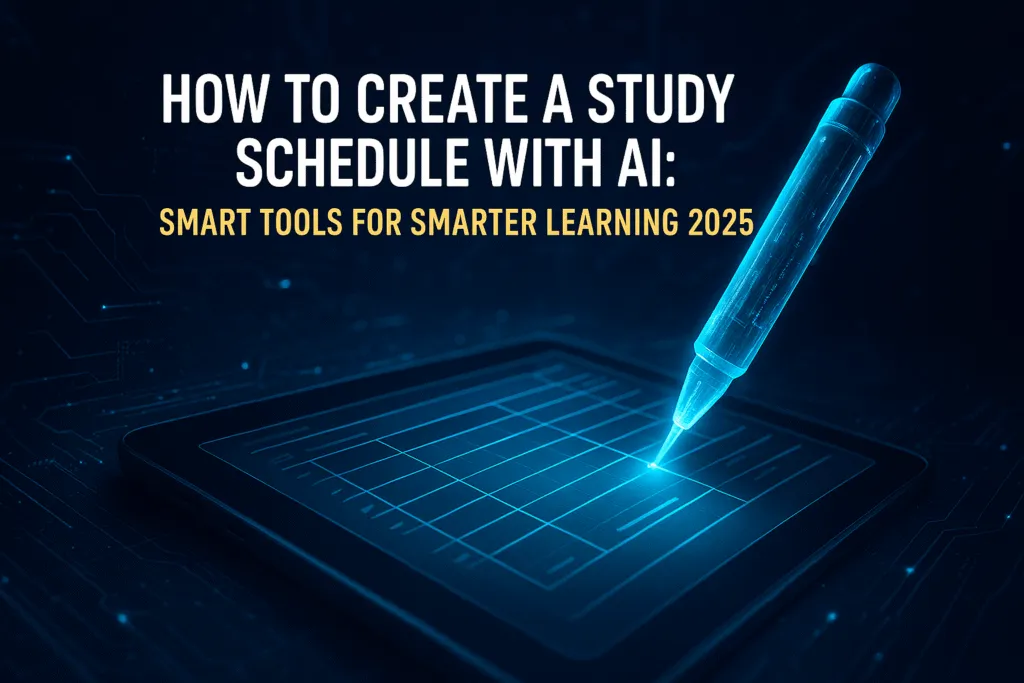Introduction
In 2025, chatbots have become more than just digital assistants—they are now powerful tools integrated into our daily lives. From answering customer queries and writing emails to helping developers code and students study, these AI-powered assistants are everywhere. But have you ever paused to think about how chatbot works behind the scenes?
As a tech blogger, I’ve explored countless AI platforms, and one thing is clear—chatbots like ChatGPT, Gemini, Copilot, and DeepSeek XAI have completely changed the way we interact with machines. Unlike older chatbots that followed a fixed script, today’s systems use something far more intelligent: Large Language Models. These models don’t just respond—they understand context, adapt to your tone, and generate responses that feel surprisingly human.
What makes this possible is a combination of machine learning, deep learning, and natural language processing. Chatbots are trained on massive datasets, learning patterns in human language so they can generate accurate and relevant replies. The result is a system that feels more like a conversation with a real person than a machine.
Understanding how chatbot works is not just for developers or AI enthusiasts anymore. It’s becoming essential knowledge for anyone working with technology. Whether you’re using AI tools for productivity, learning, or content creation, knowing what’s happening under the hood helps you use them more effectively—and responsibly.
In this blog, we’ll break down how popular chatbots like ChatGPT, Gemini, Copilot, and DeepSeek XAI function, compare their strengths, and look at what’s coming next in the world of conversational AI.
Stay with me as we dive into the fascinating world of modern chatbots and explore the tech that makes them tick.
What Is a Chatbot?
A chatbot is a software application designed to simulate human-like conversation with users. It can respond to messages, answer questions, and even carry out tasks based on the input it receives. While chatbots have existed for years, the way they function has drastically changed—especially with the rise of artificial intelligence. Today, understanding how chatbot works means looking at more than just pre-programmed scripts; it’s about understanding intelligent systems that learn and adapt.
Earlier chatbots operated using rule-based systems. These followed fixed decision trees—if you say “hello,” the bot replies with a scripted greeting. While effective in limited scenarios, they couldn’t handle complex or unpredictable conversations. Modern chatbots, on the other hand, use AI-powered models that understand natural language and context. This allows them to respond in real-time, make suggestions, and even generate original content.
There are two main types of chatbots in use today: rule-based and AI-based. Rule-based chatbots are limited in flexibility and require manual programming. AI-based chatbots, like ChatGPT, Gemini, Copilot, and DeepSeek XAI, are powered by machine learning and natural language processing. They can handle open-ended questions, follow conversation history, and provide personalized answers—something that was nearly impossible just a few years ago.
Whether you’re chatting with a bank’s support bot or using an AI writing assistant, you’re interacting with a chatbot that likely uses complex models behind the scenes. These models are trained on vast amounts of data and refined to produce responses that are not just accurate, but also conversational and context-aware.
In short, if you’ve ever wondered how chatbot works, the answer lies in a blend of smart algorithms, massive datasets, and a deep understanding of human language. And this is just the beginning—we’re only scratching the surface of what chatbots can truly do.
Core Technology Behind Chatbots
To truly understand how chatbot works, it’s important to explore the core technologies that power these intelligent systems. Chatbots today are far more advanced than the scripted bots of the past. They rely on a blend of artificial intelligence, natural language processing (NLP), and deep learning to create conversations that feel natural and human-like.
At the heart of most modern chatbots is Natural Language Processing (NLP). This branch of AI helps machines understand, interpret, and generate human language. NLP allows chatbots to break down user input, identify intent, extract key information, and generate relevant responses. Whether you’re typing casually or asking a technical question, NLP helps the chatbot make sense of your words.
Next comes Machine Learning (ML), which allows chatbots to learn from large datasets. By training on conversations, books, articles, and more, the model learns grammar, logic, tone, and even cultural context. Over time, it gets better at predicting what to say next. This is how chatbot works in a way that feels intelligent rather than robotic.
A major breakthrough in chatbot technology came with transformer models, especially the Large Language Models (LLMs) like GPT (used in ChatGPT) or Gemini’s proprietary models. These models process vast amounts of text data and generate responses based on probability—predicting the next word in a sequence based on previous input.
Another key element is deep learning, which uses layers of artificial neural networks to simulate how the human brain processes information. This allows chatbots to understand not just words, but the deeper context and emotions behind them.
Together, these technologies enable chatbots to understand questions, hold multi-turn conversations, provide relevant answers, and even generate creative content. As these systems improve, so does our interaction with them—making chatbot conversations smarter, faster, and more human every day.
How ChatGPT Works
ChatGPT is one of the most well-known AI chatbots in the world, developed by OpenAI. It’s built on a powerful family of models called GPT, short for Generative Pre-trained Transformer. To understand how chatbot works in the case of ChatGPT, we need to look at how it processes information, generates responses, and improves over time.
ChatGPT works by predicting the next word in a sentence based on the input it receives. It doesn’t “think” in the human sense, but it’s trained on massive datasets containing books, websites, code, dialogues, and more. This helps it learn patterns in language, logic, and context. When you ask a question, it breaks down your prompt, looks at similar patterns it has seen during training, and generates the most likely response—one word at a time.
The technology behind ChatGPT is a type of Large Language Model (LLM). These models are based on a transformer architecture, which is great at handling large sequences of text and understanding the relationship between words. This is why ChatGPT can handle complex queries, follow up on previous messages, and provide responses that feel natural.
OpenAI also uses a method called Reinforcement Learning from Human Feedback (RLHF) to fine-tune ChatGPT. This means human trainers rate and guide the model’s responses, helping it learn what is helpful, safe, or accurate. This extra layer of training makes ChatGPT more reliable and user-friendly compared to models trained only on raw data. ChatGPT works by predicting the next word in a sentence based on the input it receives. It’s built on the powerful GPT architecture developed by OpenAI.
In simple terms, how chatbot works in ChatGPT’s case is a mix of deep training, smart prediction, and human-in-the-loop feedback. It’s not just answering questions—it’s recreating patterns of human communication, one token at a time. And with every upgrade, it gets better at understanding what you mean, not just what you type.
How Gemini by Google Works
Gemini is Google’s next-generation AI chatbot, developed by DeepMind, and it represents a major leap in how conversational AI functions. To understand how chatbot works in the case of Gemini, it’s important to know that this tool goes beyond text—it’s designed to be multimodal, meaning it can understand and generate not just language, but also images, code, audio, and more.
Gemini is built on the foundation of Google’s earlier large language model, PaLM, but with significant upgrades. Unlike traditional chatbots that focus only on written input, Gemini can process information from multiple formats. For example, it can interpret a chart, understand a math problem, or analyze an image—all in the same conversation. This makes it highly versatile and deeply integrated across Google’s ecosystem.
The chatbot relies on deep learning and transformer-based architecture, just like ChatGPT. But where Gemini stands out is in its real-time integration with Google Search and Google tools like Docs, Gmail, and YouTube. This means it can fetch up-to-date information, summarize emails, create content drafts, or even generate code with relevant documentation—all within the same interface.
Another important part of how chatbot works in Gemini’s case is continuous improvement. Since it’s connected to Google’s data systems and user feedback loops, Gemini can be refined based on user interaction, allowing it to offer smarter, more accurate results over time.
Gemini also focuses heavily on safety and factual accuracy, using advanced filters and real-time verification tools to reduce misinformation. This gives it an edge when reliability and precision are critical. Gemini is Google’s next-generation AI chatbot, developed by Google DeepMind’s Gemini team to handle both text and visuals.
In short, Gemini works by combining language understanding with real-world data access and multimodal learning. It’s not just answering your questions—it’s drawing from a wide range of information sources to help you get things done more effectively.
How Microsoft Copilot Works
Microsoft Copilot is not just a chatbot—it’s an AI-powered assistant designed to enhance productivity across Microsoft’s suite of tools like Word, Excel, PowerPoint, Outlook, and even Visual Studio. To understand how chatbot works in the case of Copilot, we need to look at how it combines natural language understanding with real-time integration into software you already use daily.
At its core, Microsoft Copilot is powered by OpenAI’s language models (like GPT-4), hosted on Microsoft’s Azure cloud. It works by taking your natural language input—whether it’s a sentence, question, or command—and transforming it into actions or suggestions within apps. For example, you can ask it to summarize a long email thread in Outlook, generate a project timeline in Excel, or draft a blog post in Word, all using simple prompts.
What makes Copilot unique is its deep integration into Microsoft 365. It doesn’t just provide generic responses; it understands the structure and context of your documents, spreadsheets, or codebase. So when you ask it to analyze a table or generate a report, it pulls directly from your current file, making the result highly relevant and personalized.
Another important part of how chatbot works in Copilot’s case is context awareness. It can access your recent files, emails, meetings, and calendars—based on the permissions you grant—and use that data to give context-rich answers or suggestions. This is especially powerful for professionals who deal with large volumes of information.
Microsoft also places a strong focus on data privacy and enterprise-grade security, ensuring that your inputs and documents stay protected within your organization’s cloud.
In summary, Microsoft Copilot works by blending powerful language models with your personal or organizational data, allowing it to act as a smart assistant that not only understands your instructions but also executes them within your workflow.
How DeepSeek XAI Works
DeepSeek XAI is a rising player in the world of AI chatbots, developed with a focus on transparency, performance, and open access. To understand how chatbot works in the case of DeepSeek XAI, it helps to look at both its technical foundation and its unique goals compared to more commercial models like ChatGPT or Gemini.
DeepSeek XAI is based on Large Language Model (LLM) architecture, similar to GPT and other transformer-based systems. It processes user inputs by breaking down the language, understanding context, and generating a relevant response one word at a time. However, what sets DeepSeek apart is its commitment to open-source development and cross-language capability, especially in Chinese and English.
The model is trained on massive multilingual datasets that include not only English web content, but also academic papers, code, and Chinese-language sources. This allows it to perform strongly in multilingual environments, which is especially valuable in global settings. If you’re wondering how chatbot works when it has to switch between languages or respond in both technical and conversational tones, DeepSeek XAI is a great example of that versatility.
Another notable feature is its focus on explainability—hence the “XAI” in its name (Explainable AI). DeepSeek emphasizes making its model outputs understandable and auditable, which appeals to researchers and developers who want more transparency from AI tools.
Because DeepSeek is open source, developers can study, fine-tune, and deploy it for custom use cases. This makes it different from closed systems like ChatGPT or Gemini, which are more controlled by the companies behind them.
In short, DeepSeek XAI works by combining advanced LLM technology with a transparent, multilingual, and developer-friendly approach. It’s a chatbot built not just to answer questions, but to push forward how we understand and trust AI responses.
What’s Common in All These Chatbots
While ChatGPT, Gemini, Copilot, and DeepSeek XAI are developed by different companies with different goals, they all share some foundational technologies and principles. If you’re trying to understand how chatbot works at a deeper level, it’s useful to know what ties these powerful tools together.
The most important common factor is the use of Large Language Models (LLMs) based on transformer architecture. This design allows chatbots to process and understand long sequences of text, recognize context, and generate relevant, human-like responses. Whether you’re asking ChatGPT to write a poem or Gemini to interpret an image, the core mechanism involves predicting the next word based on input and context.
Another shared trait is the role of Natural Language Processing (NLP). NLP enables these chatbots to understand grammar, tone, intent, and even slang. It’s what allows the bots to follow up on a conversation or adjust their tone depending on the user’s mood or topic.
These chatbots also rely heavily on pretraining and fine-tuning. They are first trained on enormous datasets, ranging from websites and books to code and academic content. After that, they’re fine-tuned for specific tasks or audiences using methods like Reinforcement Learning from Human Feedback (RLHF). This is how chatbot works to become more useful, safe, and accurate over time.
Another thing they all share is their ability to handle multi-turn conversations, remembering previous context within a session. This creates a smoother, more coherent experience for the user.
Finally, they all have built-in limitations. Despite their intelligence, these chatbots can still produce biased, inaccurate, or nonsensical responses. This is why companies invest in content filtering, user feedback, and safety layers.
So, whether it’s ChatGPT or DeepSeek, the underlying structure of how chatbot works remains largely the same—smart algorithms, powerful models, and a lot of data behind the scenes.
How Chatbots Are Improving in 2025
Chatbots in 2025 are smarter, faster, and more versatile than ever before. The evolution is not just in how they sound but in how they think, respond, and integrate into our lives. If you’re wondering how chatbot works today compared to just a year or two ago, the answer lies in major improvements in reasoning, personalization, and multimodal capabilities.
One of the biggest changes is in reasoning ability. Newer chatbot models can now handle more complex logic, multi-step instructions, and nuanced conversation. They’re getting better at not just answering questions, but truly understanding them—even if the input is vague or layered. This makes them more useful in education, research, and professional tasks.
Another key area of improvement is personalization. Chatbots can now adapt to your writing style, remember preferences during a session, and deliver responses tailored to your needs. While full memory capabilities are still being carefully rolled out due to privacy concerns, session-based personalization is already making interactions feel more human.
In 2025, chatbots are also becoming multimodal, meaning they can handle not just text, but also images, code, audio, and even video. You can upload a chart and ask for analysis, or provide an image and ask questions about it—something that would have been impossible with earlier models.
Speed and accuracy have also improved dramatically. With lighter, more efficient models and better hardware optimization, responses now come faster without sacrificing quality.
Finally, there’s a stronger focus on safety, transparency, and trust. Developers are investing more in reducing hallucinations (AI making things up), minimizing bias, and offering better fact-checking tools.
In short, how chatbot works in 2025 is a story of evolution—AI that not only talks like us but is beginning to think more like us, too.
Challenges & Ethical Concerns
As chatbots become more advanced and widely adopted in 2025, they also raise important questions around trust, safety, and responsibility. No matter how impressive they seem, it’s critical to understand the challenges and ethical concerns tied to how chatbot works in the real world.
One of the biggest concerns is hallucination, where chatbots generate answers that sound correct but are factually wrong. Since these models don’t “know” things the way humans do, they rely on patterns rather than verified knowledge. This can lead to misinformation, especially when users trust the chatbot’s response without cross-checking.
Another major issue is bias. Because chatbots are trained on data from the internet, they can unintentionally reflect societal biases related to gender, race, culture, or politics. Even with safety filters in place, biased outputs can still emerge, making fairness a constant challenge.
Privacy and data security are also critical concerns. While most modern platforms don’t store or use your data for training by default, user inputs can still be sensitive. It’s important that platforms handle this data responsibly, especially in corporate or healthcare environments.
There’s also the risk of over-reliance. As chatbots become more capable, users might depend on them for decision-making in areas like finance, legal advice, or medical guidance—fields where incorrect information could have serious consequences.
Another ethical question revolves around transparency. Users often don’t fully understand how chatbot works or how responses are generated. Lack of clarity can reduce accountability, especially if AI is used in ways that influence opinions or actions.
In short, while chatbots are powerful tools, they’re not perfect. Understanding both their capabilities and limitations is key to using them ethically. Developers and users alike must stay aware of these concerns to ensure that AI evolves in a way that benefits everyone responsibly.
Conclusion
Chatbots have come a long way, and in 2025, they’re reshaping the way we interact with technology. From casual conversations to complex problem-solving, tools like ChatGPT, Gemini, Copilot, and DeepSeek XAI are proving that AI can be both useful and intuitive. But behind every smart response lies a deep system of algorithms, training data, and constant refinement. Understanding how chatbot works helps us see these tools not as magic, but as the result of years of research in language modeling and machine learning.
Each chatbot has its strengths—ChatGPT excels in natural conversation, Gemini stands out with its multimodal features, Copilot integrates seamlessly into productivity tools, and DeepSeek XAI offers transparency and multilingual support. Yet, all of them share a common foundation built on advanced AI models and real-world data.
As these systems grow more capable, it’s important for users to stay informed—not just about what chatbots can do, but also how they do it. That awareness can help us use these tools more responsibly and effectively, whether for learning, working, or everyday communication.
In the end, the future of chatbots isn’t just about better technology—it’s about smarter interaction. And knowing how chatbot works is the first step toward making the most of this AI-powered future.
Also Read: AI’s Dark Side: How Fake News and Deepfakes Are Hijacking Truth in 2025
FAQs
Q1. What exactly is a chatbot?
A chatbot is a software program that uses artificial intelligence to simulate human conversation. It can answer questions, follow instructions, and perform tasks through text or voice interactions.
Q2. How chatbot works in simple terms?
A chatbot processes your input, understands the context using natural language processing, and then generates a relevant response based on patterns it learned during training. It predicts the most appropriate reply one word at a time.
Q3. What’s the difference between ChatGPT, Gemini, Copilot, and DeepSeek XAI?
ChatGPT is great for general conversations and creative writing. Gemini supports multimodal input like images and text. Copilot integrates deeply with Microsoft apps like Word and Excel. DeepSeek XAI focuses on multilingual support and explainable AI.
Q4. Are these chatbots always accurate?
No, chatbots can make mistakes or generate inaccurate information, especially if the prompt is unclear. They’re improving rapidly but should still be used with human oversight in critical tasks.
Q5. Can I build my own chatbot?
Yes! There are many platforms—both open-source and commercial—that allow developers to build custom chatbots. Tools like DeepSeek and open AI frameworks make it easier than ever to get started.
Q6. Are chatbots safe to use in 2025?
Generally, yes. Reputable platforms follow strong data privacy and safety standards. However, users should avoid sharing sensitive personal or financial information unless they’re sure the platform is secure.
Q7. Will chatbots replace human jobs?
Chatbots are automating many repetitive tasks, but they also create new roles in AI training, oversight, and integration. Instead of replacing humans entirely, they’re more likely to work alongside us.













